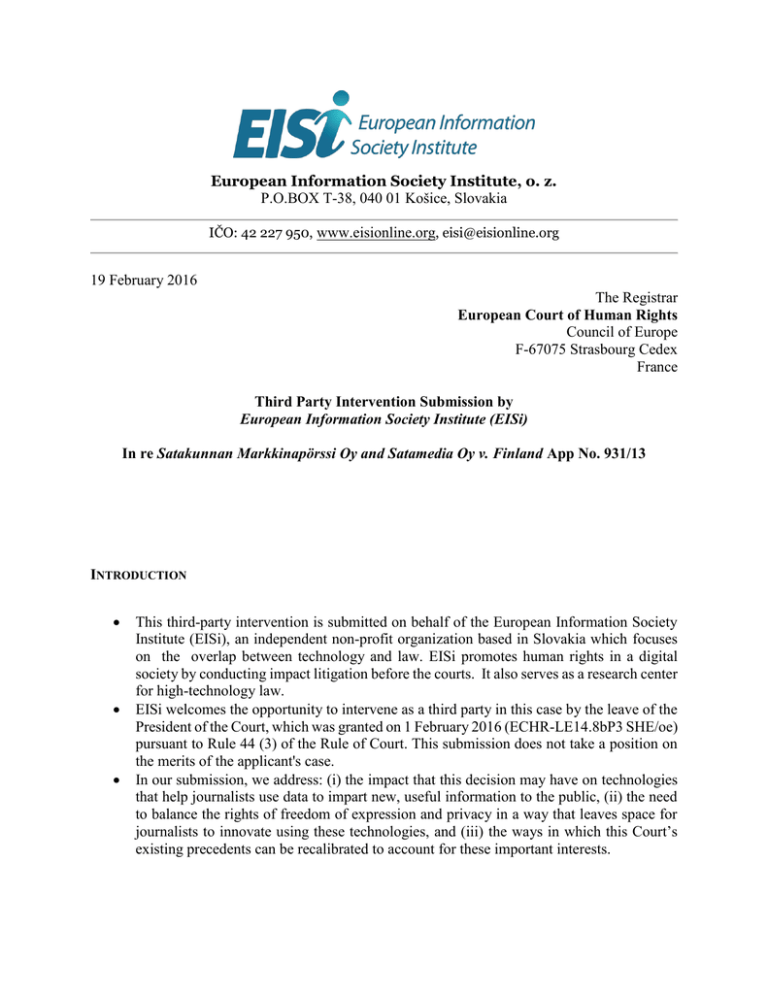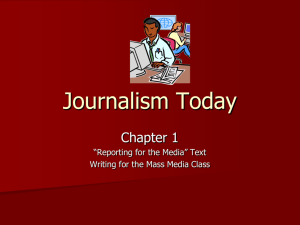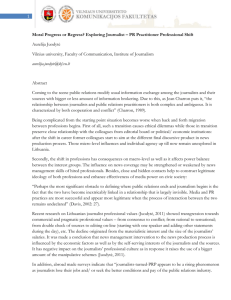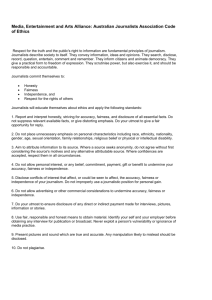European Information Society Institute, o. z. European Court of Human Rights
advertisement

European Information Society Institute, o. z. P.O.BOX T-38, 040 01 Košice, Slovakia IČO: 42 227 950, www.eisionline.org, eisi@eisionline.org 19 February 2016 The Registrar European Court of Human Rights Council of Europe F-67075 Strasbourg Cedex France Third Party Intervention Submission by European Information Society Institute (EISi) In re Satakunnan Markkinapörssi Oy and Satamedia Oy v. Finland App No. 931/13 INTRODUCTION This third-party intervention is submitted on behalf of the European Information Society Institute (EISi), an independent non-profit organization based in Slovakia which focuses on the overlap between technology and law. EISi promotes human rights in a digital society by conducting impact litigation before the courts. It also serves as a research center for high-technology law. EISi welcomes the opportunity to intervene as a third party in this case by the leave of the President of the Court, which was granted on 1 February 2016 (ECHR-LE14.8bP3 SHE/oe) pursuant to Rule 44 (3) of the Rule of Court. This submission does not take a position on the merits of the applicant's case. In our submission, we address: (i) the impact that this decision may have on technologies that help journalists use data to impart new, useful information to the public, (ii) the need to balance the rights of freedom of expression and privacy in a way that leaves space for journalists to innovate using these technologies, and (iii) the ways in which this Court’s existing precedents can be recalibrated to account for these important interests. TASK BEFORE THE COURT (1) Technology has made it easier for journalists to draw insights from otherwise unintelligible data to tell new stories. Pairing traditional reporting with data analysis can allow “data journalists” to shed light on corruption, income inequality, and a number of other issues in new and important ways. This innovative approach to reporting enhances traditional journalistic activities by allowing journalists, among others, to visualize general patterns that emerge only at an informationgathering scale that has traditionally been impossible to see. (2) This type of reporting has clear benefits for a democratic society, but the spread of tools that enable data journalism also heightens the need for safeguards to protect personal data and preserve individual privacy. Courts now face a new challenge: striking a balance between the rights of privacy and freedom of expression in light of how journalists use data about us to tell important stories about our world. This is particularly necessary because the current approach, developed in Axel Springer, addresses an entirely different sort of journalistic activity. The Axel Springer criteria focus on the rights of individuals or small groups of people in the context of initial disclosure of information, but the balance between expression and privacy should be calibrated differently when journalists need to process publically available data about millions of individuals in order to impart information that the public has a right to receive. (3) This case is an opportunity for the Court to craft guidelines that protect both the individual’s interest in privacy and society’s interest in innovative data journalism. We therefore ask the Court to consider the extent to which Article 10 of the European Convention on Human Rights (“ECHR”)1 justifies revisiting not only Axel Springer, but also other case law that might curb the rise of innovative forms of journalism that should be allowed to flourish across Europe. DATA JOURNALISM (4) Journalism has always evolved in response to innovation. For example, television transformed reporting by allowing people to see images being broadcast from around the world. Likewise, people now have the ability to access news applications, real time alerts, and social media updates from their mobile devices. 2 Newsgathering is also increasingly democratic – ordinary citizens can record firsthand experiences, add their own commentary, and share content at a scale that was once unimaginable. These citizen journalists can circumvent government censorship, whether it is imposed directly or not, while imparting important information about matters of public interest.3 The power of citizen journalism has been recognized in countries such as Mexico, as well as countries that are State Parties to the Convention.4 1 Convention for the Protection of Human Rights and Fundamental Freedoms, 1953. Also known as the European Convention on Human Rights 2 Gwen Teckel, 'Traditional Journalism: Is it Old News? '(WorldWideLearn, 5 June 2013) <http://www.worldwidelearn.com/education-articles/traditional-journalism-is-it-old-news.html> accessed 17 February 2016, also available at http://goo.gl/pYTPvw. 3 Human Rights Watch, World Report 2015: Mexico, Events of 2014, < https://www.hrw.org/worldreport/2015/country-chapters/mexico >, accessed the 17th of February 4 Charlotte Alfred, ‘Why Turkey Bans News About Terror Bombings’ (The World Post, updated 17 February 2016) <http://www.huffingtonpost.com/entry/turkey-media-blackout-istanbul-bombing_us_56957080e4b086bc1cd5a364> accessed 18 February 2016 (5) Data journalism is another example of journalists responding to innovation and shifting ideas about what society wants from its media. Far from a recent trend, it has been argued that the “age of computer-assisted reporting” started in 1952, when U.S. presidential election results were analyzed using a computer. 5 Since then, data analysis and computation has taken on an unprecedented role, enabling journalists to effectively collect, process, and analyze data that was otherwise inaccessible even a few years ago. This has heightened the ability of journalists to act as watchdogs, even though the tools and skills needed to successfully engage in data journalism are still being developed.6 Data journalism conferences, boot camps, and hackathons are now taking place in Europe and around the world, with the goal of building tools and improving skills to train journalists to take on data processing stories when they return home.7 (6) Data processing can happen at various stages and can include gathering and combining information, using software to find connections, and creating compelling visualizations of the data that has been processed.8 These visualizations can help identify trends and patterns that might otherwise go unnoticed in a spreadsheet. 9 They can also be interactive, presenting a more compelling and engaging depiction of subjects as serious as drone strike victims 10 or as lighthearted as football.11 (7) Data journalism can also involve making information that already exists more useful to the public. Some of the most successful examples of data journalism take the form of databases that aggregate information released by the government. For example, the web application ZNasichDani.sk gathers publicly available information on public procurement contracts to increase transparency in Slovakia, which is consistently ranked one of the most corrupt countries in the European Union.12 ZNasichDani.sk collects public data and uses it to automatically find “connections that you previously had to find manually using various resources”, 13 revealing the 5 Melisma Cox, The development of computer-assisted reporting, paper presented to the Newspaper Division, Association for Education in Journalism and Mass Communication, Southeast Colloquium, March 17–18, 2000, University of North Carolina, Chapel Hill. 66 Eva Constantaras, 'OpenGov Voices: Why data journalism tries, and fails, to go global ' (Sunlight Foundation, 10 February 2016) <https://sunlightfoundation.com/blog/2016/02/10/opengov-voices-why-data-journalism-tries-andfails-to-go-global/> accessed 18 February 2016 6 European Journalism Centre, open knowledge foundation, 'What is Data Journalism?' (Data Journalism Handbook, 2012 ) <http://datajournalismhandbook.org/1.0/en/introduction_0.html> accessed 18 February 2016; Constantaras, supra note 2 7 Ibid. 8 European Journalism Centre, open knowledge foundation, 'What is Data Journalism?' (Data Journalism Handbook, 2012 ) <http://datajournalismhandbook.org/1.0/en/introduction_0.html> accessed 18 February 2016 9 Norman Shamas, 'Why Data Visualization is Important ' (TechChange, 19 May 2015) <https://www.techchange.org/2015/05/19/data-visualization-analysis-international-development/> accessed 19 February 2016 10 European Journalism Centre , 'Out of Sight, Out of Mind: Using visual tools to reveal the human impact of drones' (Data Driven Journalism , 27 January 2016 ) <http://datadrivenjournalism.net/featured_projects/out_of_sight_out_of_mind_using_visual_tools_to_reveal_the_hu man_impact_of_d> accessed 18 February 2016 11 Charles Perin, Romain Vuillemot, Jean-Daniel Fekete, 'SoccerStories: A Kick-off for Visual Soccer Analysis ' (Aviz, 2013) <http://aviz.fr/wiki/uploads/Research/soccerstories.pdf> accessed 18 February 2016 12 Eva Vozarova, ZNasichDani.sk: Making procurement data matter more, June 1 2012, < http://www.epsiplatform.eu/content/znasichdanisk-making-procurement-data-matter-more > 13 Theodora Middleton , 'Why censoring Slovak spending app means bad news for open data ' (Open Knowledge type of corruption that “often appears in business transactions between private companies and the state, and necessarily has to be connected to non-standard personal relationships between key players.”14 Another example of this is an award-winning collaboration between Transparency International’s Argentinean chapter and La Nación, a national newspaper. These groups built a user-friendly database that compiles information from the asset declarations of public servants, which are “publicly available but not easy to access or understand.” 15 By aggregating this information, Transparency International and La Nación were able to present otherwise inaccessible data as an interactive visualization that allows citizens to engage with asset declarations in a meaningful and useful way.16 (8) Making data accessible can also mean conveying information to the public through devices like mobile phones. As of August 2012, for example, more than 76 million farmers in Indonesia, Nigeria, India, and China used subscription-based SMS services to access information about crop prices, weather conditions, and other farming tips to their phones. 17 Some of these service providers also share information based on data entered by the customers themselves - enabling farmers to learn about fertilizer, irrigation, pesticide, and crop practices from one another. This information might have been publicly available from independent sources, but sending it directly to their phones in a useful format means the information can actually improve farmers’ daily lives. In a similar way, when journalists process information and impart it to mobile devices it may be, at least in some cases, an important part of the way they are imparting information to the public. (9) Making data more accessible can also create opportunities for citizens and journalists to “systematically crowdsource and organize materials and context on key ongoing issues” to efficiently identify issues that are worth investigating. 18 This can even help with government investigations and law enforcement, too. For example, the International Consortium of Investigative Journalists (“ICIJ”) spent thousands of hours analyzing leaked documents to expose the tax evasion practices of more than 370 companies. The resulting “Luxembourg Leaks” and “Swiss Leaks” projects won the Global Editor’s Network “Investigation of the Year” data journalism prize in 2015. The ICIJ also created “interactive applications to allow the public to Foundation Blog, 18 July 2011) <http://blog.okfn.org/2011/07/18/why-censoring-slovak-spending-app-means-badnews-for-open-data/> accessed 18 February 2016 14 Vozarova, supra note 12 15 Transparency International , 'Visualizing corruption: Award-winning data journalism in Argentina ' (1 August 2014) 16 Ibid. <http://www.transparency.org/news/feature/visualising_corruption_award_winning_data_journalism_in_argentina> accessed 18 February 2016 17 Caspar Van Vark, 'Empowering farmers through SMS ' (The Guardian , 27 November 2012 ) <http://www.theguardian.com/global-development-professionals-network/2012/nov/27/farmers-mobile-phones-smsagriculture> accessed 18 February 2016 18 Subramaniam Vincent, 'How can city newsrooms track and capture data from complex issues independent of reporters’ efforts?' (JSK at Stanford , 15 November 2015) <http://jsk.stanford.edu/journalism-challenges/2015/howcan-city-newsrooms-track-and-capture-data-from-complex-issues-independent-of-reporters-efforts/> accessed 19 February 2016 explore as much data as possible from each leak”.19 These datasets enabled the French government to recover at least €3 billion in unpaid taxes.20 (10) These examples highlight how, and why, journalists process data about individuals, the government, or corporations to make it more accessible and understandable. In that sense, data journalism is fundamentally different than traditional journalism, which calls attention to information about one individual or a small group. Data journalism is valuable not because of the status of the people involved, but because of the scale at which information is aggregated and disseminated. While care should be taken to protect personal information during this processing, it is important to keep in mind that this processing by journalists, among others, can serve the public interest even when its only goal is to make the information easier to access, understand, and use. THE RIGHT TO IMPART AND RECEIVE INFORMATION (11) We recognize the need to balance freedom of expression against other rights with which expression might collide. However, narrowly tailoring the rights to impart or receive information when they implicate competing rights, like privacy, frustrates the ability of journalists to impart information using technologies that play an increasingly important role in the way journalists around Europe tell important, insightful stories: “...the press plays an essential role in a democratic society. [..] it must not overstep certain bounds, in particular in respect of the reputation and rights of others and the need to prevent the disclosure of confidential information, its duty is nevertheless to impart – in a manner consistent with its obligations and responsibilities – information and ideas on all matters of public interest.”21 (12) We therefore encourage this Court to apply Article 10 in light of the important consequences this case will have for all the technologies that journalists and the public use to receive, analyze, and impart information. This includes technology like the SMS service at issue in this case, but it also includes technology that did not exist when Satamedia’s service was developed. Many of these technologies are discussed in the previous section, but they include tools that are critical for combatting corruption, imparting information to the public, avoiding censorship, and making existing information that is already available more accessible and useful. How this Court permits national authorities to frame the scope of the rights to impart and receive information will affect how courts across Europe approach these innovative technologies on which journalists increasingly rely. (13) The Finnish Supreme Administrative Court, based on a ruling by the Court of Justice of the European Union, interpreted the relevant derogation for journalistic activities – protected by 19 The International Consortium of Investigative Journalists , 'Luxleaks, Swissleaks win top data journalism award ' (ICIJ, 18 June 2015 ) <http://www.icij.org/blog/2015/06/luxleaks-swissleaks-win-top-data-journalism-award> accessed 19 February 2016 20 Cécile Schilis-Gallego, 'Leaked files reveal new details in French UBS tax evasion case' (ICIJ, 17 February 2016) <http://www.icij.org/blog/2016/02/leaked-files-reveal-new-detail-french-ubs-tax-evasion-case> accessed 19 February 2016 21 Fressoz and Roire v France (1999) App no. 29183/95. Para 45 (iii) Article 10 - “strictly” because the expression at issue involved processing data about millions of people across Finland even though this information was already public at the time.22 Allowing this holding to survive, however, will limit the ways in which journalists can impart information and the ways in which the public can receive that information. Likewise, without clear guidelines, journalists will need to fear that certain approaches to imparting information, such as those described in the previous section, will not be protected by derogations that protect journalistic activities and the right to impart information. For example, while the developers of ZNasichDani.sk worked to improve their visualizations – granting citizens unprecedented access to information enabling them to hold their government accountable for corruption – a preliminary injunction was issued against them on privacy grounds. Data journalists already face enough obstacles in collecting and analyzing data; courts should encourage rather than hinder this growing field. (14) While strictly interpreting the scope of “journalistic activities” when privacy is implicated may seem appropriate given that journalism does not traditionally involve processing personal data, analyzing massive datasets is increasingly a fundamental part of how information is imparted to the public. Processing and analyzing the full extent of available data on a topic is also an important journalistic activity in and of itself. For example, in this case analyzing tax information in bulk could have facilitated reporting on the scale of wealth inequality across different regions of Finland. To the extent that this Court agrees that data processing, as an intermediate step in the reporting process, is protected by Article 10, it should also consider that providing access to data in a more accessible format, through a database or interactive service, is also protected. (15) Yet the Finnish Supreme Administrative Court denied the applicant Article 10 protection because of the “extent” of the information published and analyzed in this case. It even noted that “publication of the whole database” even if published “for journalistic purposes could not be regarded as journalistic activities.”23 This approach admits that regardless of whether a journalist is engaged in legitimate reporting, their ability to provide access to information of public interest may be restricted based on the “extent” of the information they make available. This raises doubts about whether journalists can process information and then make that information, and not just their stories about the information, available to the public. (16) Additionally, the Finnish Supreme Administrative Court, along with this Court, did not explain how much data processing is too much. Journalists, among others, have been left with an unwritten mandate to avoid making too much information available to the public even where the information at issue is already available to the public generally and where making the information available is concededly important. (17) Finally, in many cases “publication of the whole database” in a format that is more readable and accessible is itself an act of imparting information to the public that promotes the public’s right to receive information. That the freedom of expression includes a right to impart information and a right of the public to receive information is supported by the case of The Observer and the Guardian v. the United Kingdom.24 This Court also held that publicly available information should 22 Satakunnan Markkinapörssi Oy and Satamedia Oy v. Finland (2015) App No. 931/13. Para 70 23 Ibid. The Observer and The Guardian v. United Kingdom (1991) App no. 13585/88. 24 not be prevented from being disclosed, as it also did in the case of Bluf! v. The Netherlands25. However, these cases are different from the Satamedia case in several ways. First of all, they concern a horizontal relation where the state wants to prevent a newspaper from disclosing information concerning government agencies. Secondly, the information was about government agencies, whereas the Satamedia case deals with the personal information of 1.2 million Finnish citizens. Lastly, the aims differ: the aim of the United Kingdom and the Netherlands was to protect national security, whereas Finland wants to protect the right to privacy of its citizens. Thus, the conclusions of the case of The Observer and the Guardian and Bluf! v. The Netherlands cannot be applied equally to the Satamedia case. Nevertheless, we want to draw attention to the opinion of Lord Bridge in the domestic proceedings of the Observer and the Guardian case, where he said that “the attempt to insulate the [...] public from information freely available elsewhere was a significant step down the road to censorship characteristic of a totalitarian regime.”26 (18) If the right to receive information includes a right to receive information in an accessible format, then the SMS service at issue in this case deserves at least some Article 10 protection. But the Finnish Supreme Administrative Court held that Satamedia’s SMS service merely provided tax information without comment and therefore did not merit heightened protection. However, databases themselves can sometimes impart information and enable the public to receive that information. For example, the value of the asset declaration database created by Transparency International and La Nación, discussed above, is that it exists, regardless of whether journalists pair this data with explicit commentary or lengthy news articles. Continuing to withhold Article 10 protection when journalists publish databases, therefore, jeopardizes protection for a wide range of activities that journalists engage in as a means of imparting information to the public. (19) A right to receive unintelligible information, or information that is deliberately provided in a format that makes it difficult to understand, is a hollow guarantee. But in many cases that is how information is made available, at least initially.27 Tools such as paper document conversion are needed to quickly and efficiently obtain data from “document dumps”, such as large quantities of scanned documents from government agencies.28 Journalists are actively working to create these tools – for example, FOIA Machine empowers citizens and journalists to request public records by automating the often time-consuming and confusing process of submitting Freedom of Information Act requests to the U.S. federal government.29 When journalists are able to more effectively access data or make it available to the public through interactive services, like the SMS service at issue in this case, they further the public’s right to receive information while also engaging in an act that imparts information to the public. In the future, providing access to interactive services on issues of public concern, like the database created by Transparency Vereniging Weekblad Bluf! v. The Netherlands (1995) App no. 16616/90. The Observer and The Guardian v. United Kingdom (1991) App no. 13585/88. Para 36 (d) (iv) 27 Lee Drutman, 'Navigating the new landscape of transparency and journalism ' (Sunlight Foundation, 22 November 2013) <http://sunlightfoundation.com/blog/2013/11/22/transparency/> accessed 18 February 2016 (“[D]atasets are still often messy and unstandardized . . . Sometimes government officials make excuses and are slow to comply with requests. When these shortcomings prevail, it is difficult for anybody to use the data for much of anything.”) 28 Jacob Fenton, 'How can journalists extract data from scanned government documents?' (JSK at Stanford , 5 November 2015) <http://jsk.stanford.edu/journalism-challenges/2015/how-can-journalists-extract-data-fromscanned-government-documents/> accessed 19 February 2016 29 ‘FOIA Machine: About’ (FOIA Machine) https://www.foiamachine.org/about/ accessed 19 February 2016 25 26 International and La Nación, may even play a more important role in imparting information than traditional journalistic activities. If new technologies cannot find protection under the umbrella of Article 10, the right to impart information, as well as the right to receive it, will be greatly impaired. BALANCING EXPRESSION AND PRIVACY (20) The balancing exercise between the freedom of expression and the right to privacy is not a new one. One of the main examples in Europe is the Stasi Records Law (Stasi-Akten-Gesetz). This law regulates access to the archives of the former East German Ministry for State Security, or secret police. The right to information is a fundamental right in German law, as is the right to protection of personal data. The Stasi Records Law shows the issues that can arise when trying to balance these two. First of all, it was decided in 1990, by the last DDR-Parliament, that the Stasi archives had to be freely accessible without being restricted by any embargoes. However, at the same time, the Stasi archives were also caught up in the discussion about the right to the protection of one’s personal data. The conclusion of this was that the Stasi archives were only accessible for researchers employed by the Stasi Records Agency (Stasi-Unterlagen-Behörde), while other researchers only had access to the archives under certain conditions, such as that the authorities decided which files they were shown.30 This example shows that the tension between access to personal data, whether it be for research or for journalistic purposes, can be impaired by other rights. (21) But this Court has never encountered a case like this, involving a challenge to data processing by a private actor at a scale like the processing in this case. Previous data protection cases, by contrast, have focused on the government’s obligation to refrain from breaching citizens’ data protection rights in situations that, for example, deal with the government intercepting telephone calls, 31 the storage and use of personal data for criminal investigations, 32 and the disclosure of personal data.33 (22) Meanwhile, case law involving interferences with the right to privacy by private actors have involved personal information belonging to one or a small group of individuals – such as the magazine stories at issue in Axel Springer and Von Hannover. The current case, however, involves the personal information of 1.2 million people being processed and published by a private actor. (23) These two sets of cases – dealing with the privacy rights of small groups of individuals or government intrusions on citizens’ general notions of privacy – are inapposite here. As explained below, the traditional factors for delineating the limits on how much information can be published and processed by private actors are not well suited to balance tensions raised by data journalism. Johannes Beleites – Zwei Grundrechten im Streit. Das Archivrecht im Spannungsverhältnis von Datenschutz und Informationsfreiheit 31 See among others Malone v. the United Kingdom (1984) App. no 8691/79, Amann v. Switzerland (2000) App. no 27998/95, Dragojevic v. Croatia (2015) App. no 68955/11 32 See among others S. and Marper v. the United Kingdom (2008) App. nos 30562/04 and 30566/04, DimitrovKazakov v. Bulgaria (2011) App. no 11379/03, Brunet v. France (2014) App. no 21010/10 33 See among others Peck v. the United Kingdom (2003) App np. 44647/98, Avilkina and others v. Russia (2013) App. no 1585/09, Sõro v. Estonia (2015) App. no 22588/08 30 (24) These factors, which the Court has previously used in balancing journalistic freedom of expression with the right to privacy, include: (1) Contribution to a debate of general interest, (2) How well-known the person is and the subject of the report, (3) Prior conduct of the person concerned, (4) Method of obtaining the information and its veracity and/or circumstances in which the photographs were taken and (5) Content, form, and consequences of the publication34 (25) Attempting to map these factors to the present case demonstrates why these criteria are not necessarily a helpful way to resolve conflicts between expression and privacy in this context. Factors 1 through 4 are all intended to evaluate the extent of the infringement upon the individual’s sphere of privacy. These factors assume that the expression is directed towards or at least about the individual. But when data journalists process information their product is rarely directed towards a particular person – the analysis may involve information about individuals, but the processing is a means for drawing insights at a larger scale, to understand patterns across countries rather than local communities. Finally, the Finnish Supreme Administrative Court’s application of factor 5 penalized the applicant for disseminating information in a form that made the information as accessible, and useful, as possible. Instead, this Court should affirm that the right to impart information, along with the right to receive information, protects journalists who choose to impart information through databases, SMS services, and other technologies which may not yet exist but that could still be bound by the outcome of this case. When data journalists make information that is concededly in the public interest available it is something to be supported, not silenced, in a democratic society. Even if the applicant ultimately fails in this case, affirming the value of imparting and receiving information in an accessible and useful format will encourage data journalists across Europe. (26) Additionally, because any restriction on the freedom of expression must be convincingly established the mismatch between Axel Springer and data journalism could justify reconsidering how Axel Springer applies in the present case. This is especially appropriate given that the margin of appreciation here is circumscribed by the interest of maintaining a free press in a democratic society.35 Moreover, the conviction in this case seems to contradict the case of Fressoz and Roire, where the information was, although somewhat differently, also published. But in this case the company was not allowed to publish or process the data as an SMS service. This seems to fall short of the proportionality requirements set out in Fressoz and Roire and it limits free expression. (27) In the end, the Finnish Supreme Administrative Court’s decision does not properly weigh the Axel Springer factors, but it also calls into question whether these factors sufficiently guarantee protection for new forms of expression that should be protected by Article 10. Therefore, this Court should consider striking a new balance and affirming its commitment to encouraging journalists to innovate through means and mediums that will continue to evolve. 34 35 Axel Springer AG v. Germany (2012) App No. 39954/08 Fressoz and Roire v France (1999) App no. 29183/95. Para 45 (iii) CONCLUSIONS: The European Information Society Institute (EISi) suggests that the Court: Revisit the way it applies its existing case law, in particular Axel Springer, in cases where journalists process information in order to impart information to the public. Extend Article 10 protection for the right to receive and the right to impart information to innovative forms of journalism, paving the way for journalistic innovation that will benefit democratic societies across Europe. Recognize that regardless of whether the applicant prevails before this Court, the standard for determining how Article 10 protects the way journalists process data will have important consequences for technologies that could not have been imagined when the applicant employed the SMS service at issue.






